Adaeze, Angel, Elyse, and Kimberly (Team 2)
Artist’s statement
Select takes on the classic prompt-answering game but calls for players to use their camera roll as their responses. The game motivates players to not only share what is in their camera rolls but to introduce themselves and build relationships with a group of strangers, or to strengthen their bonds with the friends that they already have. What is a better way to do so than with photos?
Select creates an environment to unveil more about each player through humorous contextualization, reminiscing on happy memories, and sharing interests. With games that are similar, it is difficult to understand other players beyond their sense of humor. However, with Select, one can play the game and learn more about each other through the media and memories that they have had stored for years accompanied by background stories. With the game’s wide range of prompts, there is room for many memorable moments to make their way into the lives of the players, maybe they’ll take their own photos and use those the next time they play!
Concept Map
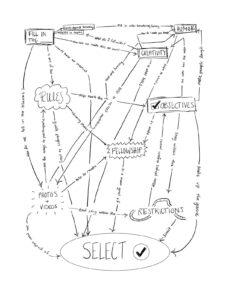
Initial Decisions, Formal elements, & Values
After our first section, we had formed a group after gravitating towards the initial concept, “Cards Against Humanity but with your own photos.” We knew we wanted to make a folk game without any digital component, but we weren’t sure how to incorporate anonymous photo sharing without some kind of online system. We all brainstormed separately, then combined initial thoughts and questions into a shared document for Checkpoint 1. Through this initial brainstorming, we ultimately formed the game entitled Select. Select is designed for 3+ players and the rules and procedures are as follows:
Shuffle the colorful prompt cards and place them in a pile, face down in the center of your group. Do the same with the black restriction cards, placing them face down in a separate pile. The player who has the most recent photo in their camera roll begins as the judge, choosing a prompt card and a restriction card from the top of each deck. Don’t choose a restriction card if your prompt says (No restriction card). Play continues as follows:
- The judge reads the prompt out loud, followed by the restriction card (if there is one), and flips the hourglass.
- Before time runs out, all other players must choose a photo or video from their camera roll that responds to the prompt and optionally conforms to the restriction card.
- After time is up, each player places their phone face up in the middle of the group with their selected photo or video on the screen. If they can’t select something in time, they place their phone face down, and pass this round.
- The judge chooses the photo or video that they believe best fits the prompt. The judge may ask players for additional context if it is unclear what is in the photo or video. The judge then presents the prompt card to the winning player, as well as the restriction card if they conformed to it.
- The player to the left of the judge now becomes the judge.
- Repeat steps 1-5 until someone has won 12 cards, including restriction cards – this player wins the game!
We admired the ability of Cards Against Humanity to both provide humor and conversation starters for its players. Inspired by this, we hoped to create a game that similarly hinges on humor while allowing for players to learn more about one another via their phone’s camera roll. Given the camera roll’s stark difference from social media as a sort of “unfiltered” view of one’s life, we envisioned the camera roll as a strong opportunity for players to share humorous, vulnerable, revealing, or nostalgic photos with one another such that they can gain glimpses into one another’s lives that they may not otherwise get. While Select involves a points system, we were ultimately focused on fellowship and expression as forms of fun. As each player selects a photo from their camera roll to share, they engage in an act of expression, choosing something to share from their personal photo collection that is a reflection of them. And because the humorous nature of prompts often lead to humorous photos being selected, a natural inclination arises among players to ask one another questions about their photos. The natural conversations that form for each round thus promote fellowship as a form of fun where players easily interact with and learn from each other.
Similar to other judging games such as Apples To Apples or Cards Against Humanity, Select features multilateral competition in which all players compete against one another to win the most points. The competition however is complicated by the obstacles imposed by the restriction cards and the timer. In limiting the photos that players may select from, the mechanic of restriction cards creates a dynamic that is more challenge focused, as opposed to the situation in which players aimlessly scroll through their camera roll. While the restriction cards may make Select more challenging, they also serve to focus a player’s photo search within the limited time they have available. As opposed to scrolling through hundreds, or even thousands, of photos to find the perfect match in just 45 seconds, restriction cards recenter the player such that their search is narrowed even further than what the prompt card commands.
Select is played best when players are sitting in a circular orientation, delineating the boundaries of the game to this “magic circle” of sorts. The boundary of Select is a bit more unique than other judging games however because of the inclusion of the digital realm. With mobile devices being a core part of the gameplay experience, the boundary of Select includes both the physical space that players share to observe one another’s photos and the digital space that they engage with while selecting their photos. This transcendental boundary however introduces additional distractions to the game that may not exist in games that are bounded purely by physical space. Because Select involves players using their phones, it becomes easy for players to engage with notifications and other content that are not associated with the game. This potential for distraction though is combatted through the mechanic of the timer which creates a dynamic in which players must remain focused such that they are able to select a photo before time runs out.
When it came to the premise and graphic design of Select, we opted for a minimalist design featuring motifs that are reminiscent of mobile phone camera roll applications. For example, the front of the box includes a logo, comprised of prompt cards, that is similar to that of Google and iOS’s photo application logos.
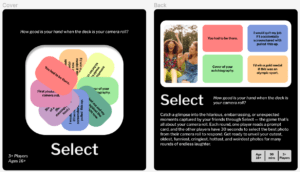
Front and back designs of the Select game box which stores the prompt and restriction cards.
We were hoping to keep the design and premise minimal, such that the focus remains on the players and their photos as opposed to an arbitrary theme. In addition to this, we were hoping that the minimalist graphic design would lend a hand to a feeling of sophistication that reinforces the suggested age of 16+. Given that some prompts may not be appropriate for younger players, we wanted to ensure that the graphic design promotes a tone of maturity.
Testing and iteration history
In total, we conducted four playtests and integrated between each one based on our feedback and notes. The main questions that emerged from our initial group session, which we wanted to address in our first playtest were:
- Should people submit their photos anonymously?
- Should we restrict the set of photos players have access to?
- Do we need to make an app for this to work?
Playtest 1
We created a deck of 50 prompts for Checkpoint 2 (like in Apples to Apples or Cards Against Humanity) and playtested in class with a mix of our own teammates and other students in the class. We created a mix of silly, revealing, and wholesome prompts, such as:
“worst thing to see on shrooms”
“You at your lowest point”
“Family photo”
We conducted our first playtest in class with other students. Each round’s time was kept with a 1 minute hourglass timer. When time was up, the judge would go around the circle, and each player would show them the picture they’d chosen on their phone. The judge of the following round was the winner of the previous round.

Playtest 1 materials: deck of cards and hourglass.
We received the following feedback from the playtesters:
- One minute was too long. People were often ready long before the time was up, creating awkward pauses while everyone waited for the timer to ring.
- The fact that the judge was the winner of the last round created a cycle where the same few people were judges throughout the entire game.
- When people were showing their pictures to the judge, it was hard for other players to see.
- The prompts were fun!
Playtest 2
To account for the pauses in the previous playtest, each round was shortened to 30 seconds. To account for the inequality in judging, we changed the rules so that the judge of the following round was the person to the left of the previous judge (clockwise). Again, this playtest took place in class and features a mix of our own teammates and classmates.
This time, we received feedback that the 30 seconds was too short – especially because sometimes, players would want a photo that was far back in their gallery and had to scroll for a while before reaching it. We asked our playtesters about the different ways they navigated their camera rolls when searching for an old or obscure item, and got the following responses:
- Just keep scrolling (takes too long)
- Use categories like Videos, Screenshots, Favorites
- Navigate by year to quickly go back in time
- Search by keyword
These insights inspired us to create “restriction cards”, which leveraged these categories while adding another layer of challenge. A restriction card might say something like “select a video” or “select something from 2016” and was paired with one of the prompts to create a restriction on the types of media players could choose. We hoped that this would encourage players to leverage the existing categorization within their camera rolls to find what they’re looking for quickly, while encouraging them to scroll beyond their recent photos.
Playtest 3 (video)
Our third playtest was also class, but did not include any of the team members as players. This was the first playtest in which we introduced restriction cards. With each prompt, a user drew a “restriction card” that limited the media they could choose from (a certain year, what type of media, etc.). The time for each round was extended to 45 seconds to account for the feedback on time from the previous two playtests. We also experimented with an end condition – playing until we ran out of prompt cards – as our previous tests had just ended when we ran out of class time.
One rule that emerged naturally in this playtest was players setting down their phones to submit their photos. This worked well, because players who couldn’t meet the time limit were naturally eliminated from the round since their phones weren’t on the table. Additionally, this made it easier for the judge to view the photos, as they could pick up the phones for a betting look, and play videos whenever they were ready.
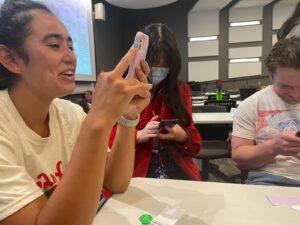
Playtest 3: three players smiling while looking at their phones
Players had a few questions about the wording of our restriction cards. For example, “Select a photo from last year” could mean this calendar year, the previous calendar year, or the school year. Did “Select a screenshot” also include screen recordings? The answer to these questions didn’t actually matter much in the scheme of the game, but this confusion and debate distracted from the gameplay, so we knew we needed to avoid ambiguous prompts and restrictions.
After running out of time, we realized that our end condition didn’t match our estimated play time of 30 minutes – we’d spent 35 minutes playtesting and hadn’t even gotten through half of the prompt cards. We also received feedback that the restriction cards were sometimes too restricting. Some players didn’t have cards that fit both the restriction card and the prompt, so they would have to opt out of several rounds.
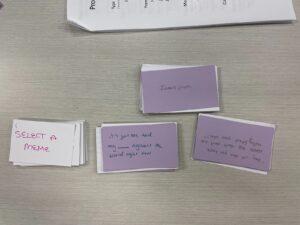
A tricky pairing of restriction card (left) and prompt (right)
We had a few ideas for how we might fix the issue of restriction cards being too restrictive:
- Some prompt cards could be labeled as “No restriction card”
- Make restriction cards an optional bonus
We implemented both solutions in our fourth and final playtest.
Playtest 4 (video)
We conducted our final playtest with a more polished physical copy of our game via the print-and-play we created. Each teammate brought a friend to play, so we ended up with a group of 4 strangers.
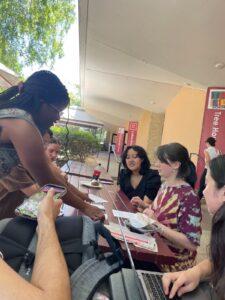
Final playtest: playing with friends at Tresidder
We chose an end condition of whoever won 7 cards first (including restriction cards if the player conformed to the restriction), as playing through the entire deck would take about an hour minimum. We made it so that restriction cards were an optional bonus. We also made the unofficial rules from our previous playtest official: when time is up, everyone puts their phone face up on the center of the table for everyone to see. If a player cannot find a photo (or video), they should put their phone face down in front of them to signify that they are not playing in that round.
Some of the game mechanics that had solidified over the past few playtests – 45 second timer, using categories to navigate, and placing phones face-up – continued to work well. After playing a full game in about 15 minutes, one player said “that was fun!” while another shared, “that was more fun in theory than in practice.” Another salient comment was that Select would look very different with a group of friends, since it was hard to gauge whether to be humorous or straightforward when playing with strangers. If we had more time, we would have loved to test this theory with a group of close friends.
We received feedback that the 7 card objective was too low, as it would only take 4 turns for a player to win in an ideal situation. We also received feedback that there wasn’t equality in the specificity of the restriction cards (for example, “Select a video” seemed much easier than “Select a photo from this week”).
Results
In our final version of Select, we did not conduct a playtest. We made our final rule adjustments based on the fourth playtest:
- The winner is whoever gets to 12 points first.
- Restriction cards have different point values depending on their specificity, and these point values are indicated on the card.
While we could playtest and adjust forever, we felt satisfied with how Select turned out in this final iteration. Our playtesting had led us to ideas that we hadn’t even imagined at the outset of our project, which attested to the power of good feedback!




